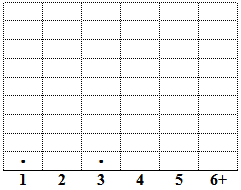Common words
| Part I - Individual and pairs work. | |
| a) |
Complete this list of what you think are the 20 most commonly used words in English.
Two words have been done for you ("I" and "the").
|
 |
|
| b) |
For each word in your list, count the number of letters it has.
Plot this number on the dot plot below. The words "I" and "the" have been plotted for you.
|
|
The words I think are most common  Number of letters in each word |
|
| c) |
Describe the shape of your graph.
What does this graph show about the length of words you think are common?
|
| d) |
Compare your graph with one other student's graph. Write their name: ___________________
i) My graph is similar / different? (Circle one of the words in bold)
ii) Explain your answer.
|
|
Part II - Group work.
|
|
| e) |
In groups of about four students, produce a graph of all the words that the students in your group had in their list.
Show how many students included each word.
|
| f) |
How can you find out the most common words that all the students in your class your class had in their lists?
|

